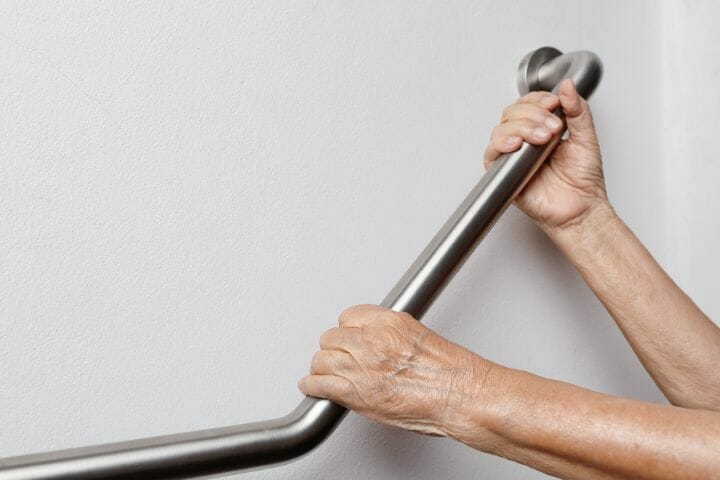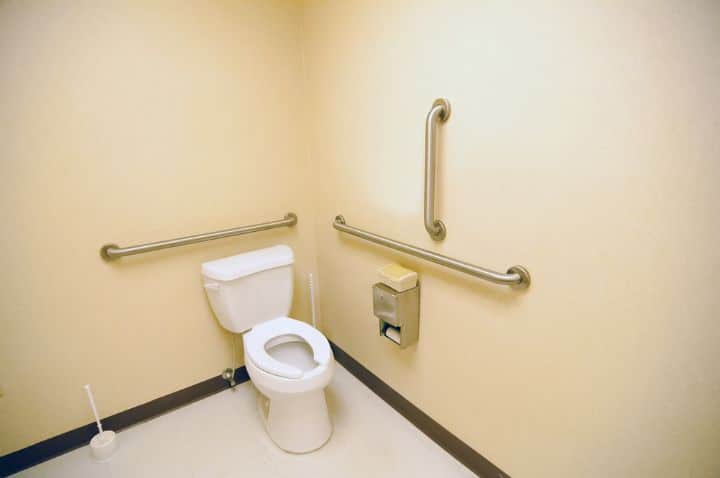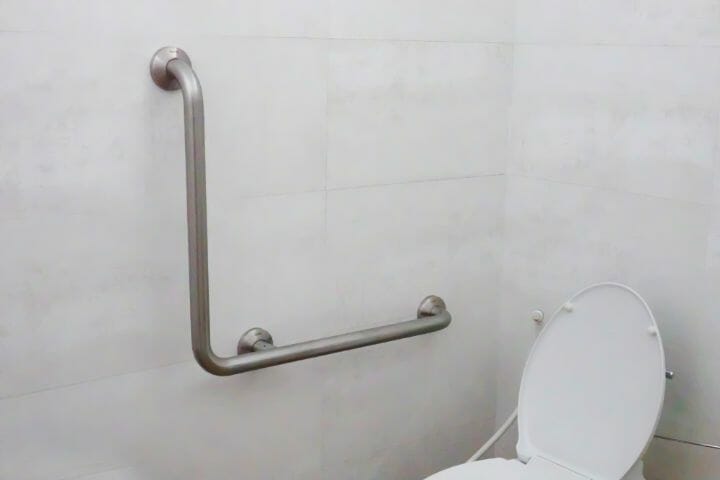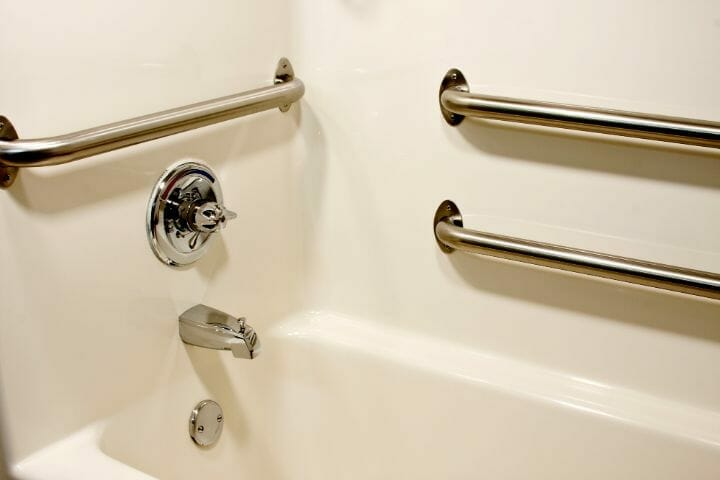Nowadays, many public spaces are being customized for safer mobility for the disabled and elderly. Modifying environments for their day-to-day needs is a step in the right direction.
Frequent falls experienced by this category of people and others too can be averted to a large extent by providing them with load-sharing equipment fixed to walls etc that help them transfer their body weight and stabilize their balance. So what exactly are these simple design but high functionality grab bars? This article will take you through this in detail.
Contents
What Are Grab Bars?
Grab bars, as the name suggests are graspable handrails fixed onto walls that assist a person in getting up, sitting down, or moving around especially in washrooms, showers, bathtubs, and so on.
They provide stability so that there are lesser chances of falls. These bars are usually cylindrical and made of different materials such as stainless steel, aluminum, steel, wood, brass, or plastic.
They are fixed firmly onto firm structures such as walls, ceilings, and floors. Grab bars help the person to hold onto to walk, climb, stand, etc
Why Are Grab Bars Needed?
- First and foremost, for stability and balance. They enable the person to stand or walk steady and avoid a fall.
- In case of a possibility of a fall, grab bars help a person to break the fall by holding onto them.
- They partially transfer the weight of the person so that the person can focus more on movement, rather than on balancing his weight.
- They are like a prop to reduce the fatigue of the individual while walking, climbing, or standing.
- They are also used by the caregiver who may need additional support while holding onto or assisting the patient in his movement.
- They can be used by the elderly, disabled, somebody feeling weak, or just about anybody who needs assistance.
What Are the Different Types of Grab Bars?
Based on their functionality, design, and usage, they can be put into the following categories:
Handrails and Support Rails
These use the support of the hands and/or arms to gain support. They are bars, usually cylindrical, that are fixed to walls and floors to help the person to stand, walk and climb. e.g. for moving up and down the stairs, next to toilet seats for standing up, in the corridors for walking back and forth, etc. These can be fixed or removable, as follows.
- Fixed grab bars and handrails: These grab bars and rails use the support of hands and are fixed permanently onto a stable structure. The difference between bars and rails is just that bars are of shorter length than rails. Both of these may be straight or angled in shape. They are fixed to walls and occasionally to floors and ceilings. They are essentially used when the person has to stand or shift their position.
- Removable grab bars and handrails: These too take the support of hands but are temporarily fixed to structures. They are again either straight or angled. For fixing, they make use of either suction cups or clamps. These can be fixed to walls, floors, ceilings, and even furniture and can be easily removed by anybody without the use of any sophisticated equipment and tools.
Hinged Rails and Arm Supports
These again use hand and/or arm support and are fixed onto walls, floors, or ceilings. They have a hinge design hence they can be folded up when they are not in use and back down when they have to be used. They help a person change or shift his position e.g. during the transfer from bed.
While grab bars are used for those that do not require much support and only need partial stabilization when doing either of these actions – from sitting to standing position or from standing to sitting position, handrails are used when the person is at a greater risk of slipping or falling, both indoors and outdoors.
You may also like Best Comfort Height Toilet For Small Bathroom
Design Considerations
- Both grab bars and railings should be so designed that they are firm and strong structures.
- They should be one long smooth piece of metal without any joints or irregularities in between.
- The ends should be sturdy to firmly hold against the structure that they are fixed to.
- They should be tarnish-resistant.
Fixation
- The ends of these structures should be fixed firmly onto walls, or to one wall and one ceiling, or one wall and one floor.
- While fixing, the surface where the bar is to be fixed should be inspected to see that it will hold the weight of the bar and the individual. This weight is known as the Safe Working Load and is the amount of load or weight that is safe for the equipment to bear without distorting or breaking.
- In the case of hinged bars, the area should always be checked so that there is no resistance in the path of opening and closing of the handrails.
You may also like Best ADA Compliant Toilets
Points To Keep in Mind While Fixing Them
- Their distance from the floor
- Their direction of fixing – horizontal, vertical, or diagonal (though ADA recommends horizontal fixation)
- The length to be used – they can be customized to any length. The standard market available sizes can also be used.
- Finish of the surface – they can be satin-finished, or anti-slip, powdered or epoxy-finished
- The individual for whom to be used – age, general physical strength, height and weight of the person, limitation of movements, etc
- The environment, indoors or outdoors, etc
Installation Guidelines:
The Americans with Disability Act (ADA) was passed by Congress in 1990 to prevent all kinds of discrimination against those with disabilities and allow them a status of equality in society. In 1992 this act was amended to Americans with Disability Act Accessibility Guidelines (ADAAG) that spelled guidelines for universal compliance.
Though medical equipment costs the governments across the world a lot of money, yet the countries, especially the developing ones may not have the access to high-quality equipment. The World Health Organisation (WHO) recommends that all governments frame appropriate policies and put them into legislation to regulate the access of equipment, control their quality and safety and check their efficacy.
To help the guiding states frame these policies the WHO came out with a publication called the ‘Medical Devices Regulations – Global overview and guiding principles ’ to help countries adapt and modify their medical devices regulations.
The Global Harmonization Task Force (GHTF) is a voluntary group of representatives from various medical devices regulatory authorities around the world e.g. the U.S. FDA whose purpose is to provide standardization of these devices.
You may also like Best Wheelchair Accessible Bathroom Sink
Location of the Grab Bars
Before installing the grab bars, it is essential to check what the physician’s recommendations are and also what the patient needs personally. In cases there is conflict, it is always best to get in touch with the physician and discuss it keeping the ADAAG in mind.
For Toilets and Water Closets
- The ADAAG recommends that the bars should be fixed horizontally at not less than 33’’ and not more than 36’’ when measuring from the floor of the washroom to the top of the bar.
- The distance between the wall and the bars should be 1-1/2’’.
- The diameter of the bar should be at least 1-1/2’’ or 1-1/4’’ for adequate grip.
- For this, the toilet seat needs to be at least 18’’ from the adjacent wall and this wall should have a minimum height of 54’’.
- Rear grab bars should be 33-36’’ from the floor with a minimum length of 36’’ (for normal toilets, not installs). From the toilet centreline, the end of the bar should be at least 12’’ from the adjacent wall and 24’’ from the centreline on the transfer side (the other side).
- The side grab bar should be a minimum of 42’’ long and at least 12’’ from the back wall.
- This requirement of 2 grab bars, one adjacent and one on the rear wall, is a must for toilets in public places.
- As per ADAAG, the weight load-bearing capacity of the grab bar should be at least 250lbs or approximately 114kgs.
For Shower Stalls
Transfer Showers Stall
Are shower booths from which a user can get in and outstanding. One L-shaped bar can be used on the wall of the faucets (control wall) or two can be used close enough to form an ‘L’.
- They should cover the entire control wall and extend to 18’’ on the back wall.
- They should be at a height of 33-36’’ from the floor of the shower.
- The diameter of the road should be 1-1/4’’ to 2’’.
- Space between the bar and wall should be 1-1/2’’.
- It should be able to bear a load of a minimum of 250lbs or 114kgs approximately.
Roll-in Shower Stall
In which a wheelchair needs to be rolled in and out.
- If there is a seat in the stall, there should be two grab bars, one on the back wall and one on the sidewall opposite the seat. There should be no bar on the wall above the seat. If there is no seat, a U-shaped bar can be installed covering all three walls, or 3 bars can be placed on the 3 walls close to each other with a minimum of 6’’ distance between each.
- The height from the floor, diameter, space between the bar and the wall, and load-bearing capacity should be the same as above.
You may also like Best Tall Toilets for Elderly
For Bathtubs
For Permanent Bath Seat Tubs
- There should be at least 3 grab bars within the tub placed horizontally.
- 2 grab bars should be placed on the back wall opposite the entrance, parallel to one another at 12’’ from the control end wall and 15’’ from the head end wall. The 3rd grab bar is placed on the control wall close to the front edge of the tub.
- The lower bar is kept at a height of 8-10’’ above the rim of the bathtub and the other grab bar is placed at a distance of 33-36’’ from the floor of the bathroom.
- Their width should be at least 24’’.
For Bathtubs With No Permanent Seats
- ADA requires 4 grab bars – two on the back wall, one on the control, and one on the head end wall.
- The bars of the back walls should be 24’’ from the head end wall and 12’’ from the control end wall. They should be a minimum 24’’ length and the lower one should be 8-10’’ from the tub rim.
- The 3rd bar should be on the control end wall and at least 24’’ in length.
- The 4th bar should be on the head end wall and at least 12’’ in length.
You may also like Best Floor To Ceiling Grab Bar Poles
Safety Tips
Since bathrooms are one of the most common places to experience a fall, one should be extra cautious when in this space. The following tips may help to avert any untoward incidents while using grab bars inside the washrooms.
- It is very important to maintain the standard height of 33-36’’ inches as specified by ADA to avoid falls due to mistakes in the judgment of location of the bars.
- Length standardizations are important so that the person may have an adequate length of support to hold onto and the hand may not slip.
- After installation, it is always a good idea to check the bars for weight endurance by yanking on them forcefully to check their grip on the wall.
- The location of the grab bars should be optimized to allow the person to use them properly. It is a good idea to follow the guidelines for the same. They will be useless if they are placed in the wrong location.
- They should be held firmly while taking support from them and let go only after the body is adequately stable.
- Accessory things such as anti-slip shower mats or shower chairs etc can be used along with grab bars to minimize accidents in the bathroom.
- Even with hand bars installed, if the person is facing difficulty in standing or sitting, then the help of any family member or caregiver should be sought.
- These bars are meant for people with balancing issues. For those who might faint in the bathrooms, there should always be someone else attending to them.
Grab bars assist an individual in leading an independent life. Though used primarily for the disabled and the elderly, they can be used for just about anybody requiring external assistance.
However, they should always be installed keeping the guidelines in mind to optimize that space for the individual. Grab bars may seem like a small step, but surely ones that lead to big changes in making societies truly inclusive for all.






